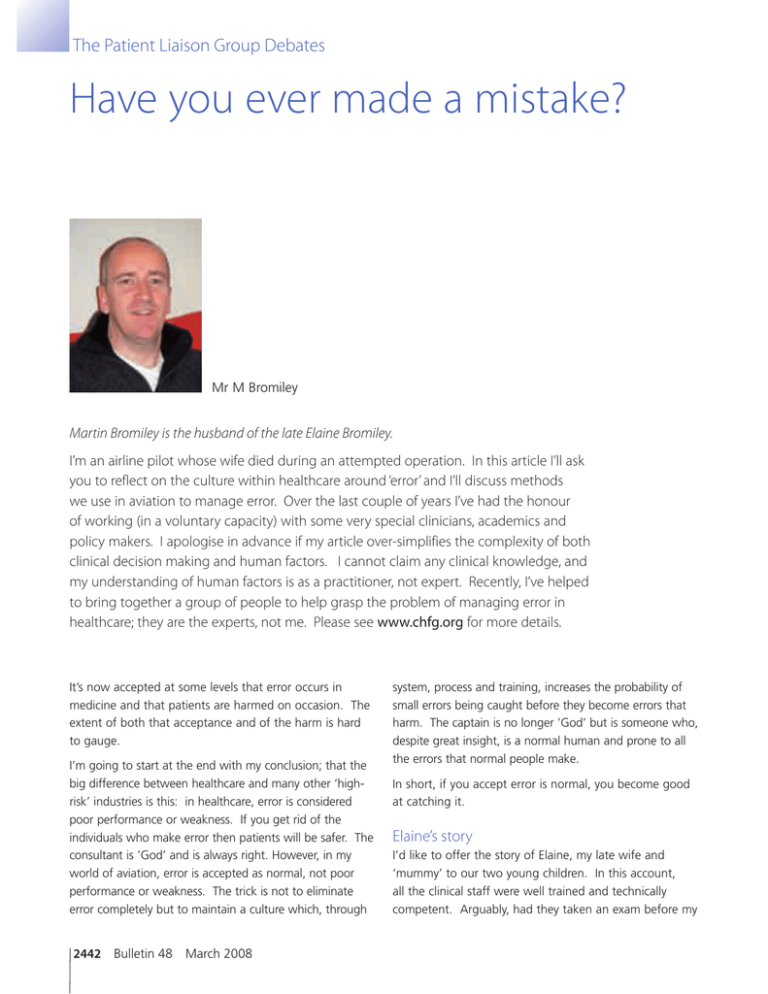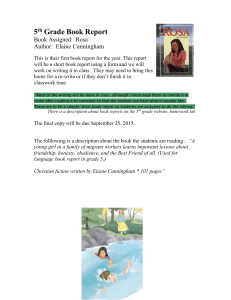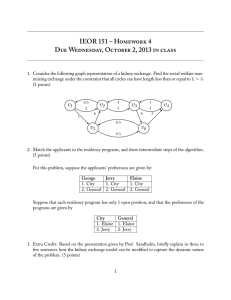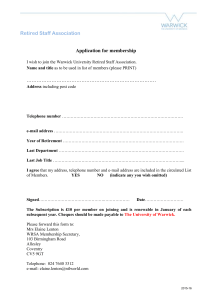Have you ever made a mistake?
advertisement

The Patient Liaison Group Debates Have you ever made a mistake? Mr M Bromiley Martin Bromiley is the husband of the late Elaine Bromiley. I’m an airline pilot whose wife died during an attempted operation. In this article I’ll ask you to reflect on the culture within healthcare around ‘error’ and I’ll discuss methods we use in aviation to manage error. Over the last couple of years I’ve had the honour of working (in a voluntary capacity) with some very special clinicians, academics and policy makers. I apologise in advance if my article over-simplifies the complexity of both clinical decision making and human factors. I cannot claim any clinical knowledge, and my understanding of human factors is as a practitioner, not expert. Recently, I’ve helped to bring together a group of people to help grasp the problem of managing error in healthcare; they are the experts, not me. Please see www.chfg.org for more details. It’s now accepted at some levels that error occurs in medicine and that patients are harmed on occasion. The extent of both that acceptance and of the harm is hard to gauge. I’m going to start at the end with my conclusion; that the big difference between healthcare and many other ‘highrisk’ industries is this: in healthcare, error is considered poor performance or weakness. If you get rid of the individuals who make error then patients will be safer. The consultant is ’God’ and is always right. However, in my world of aviation, error is accepted as normal, not poor performance or weakness. The trick is not to eliminate error completely but to maintain a culture which, through 2442 Bulletin 48 March 2008 system, process and training, increases the probability of small errors being caught before they become errors that harm. The captain is no longer ’God’ but is someone who, despite great insight, is a normal human and prone to all the errors that normal people make. In short, if you accept error is normal, you become good at catching it. Elaine’s story I’d like to offer the story of Elaine, my late wife and ‘mummy’ to our two young children. In this account, all the clinical staff were well trained and technically competent. Arguably, had they taken an exam before my The Patient Liaison Group Debates wife’s attempted operation in the emergency they were about to face, then I suspect they would have all scored highly. Indeed, at the inquest, they talked about what they should have done, but none could understand why they hadn’t taken the actions they themselves expected to have taken. We have a fair understanding of what happened because I was granted an independent review of Elaine’s care. This was conducted by Professor Michael Harmer, MD FRCA, the then President of the Association of Anaesthetists of Great Britain and Ireland. A full anonymous copy of the report and inquest verdict are available at www.chfg.org but the salient points of the attempted operation are as follows. Elaine was booked in for endoscopic sinus surgery and a septoplasty on 29 March 2005. A very thorough pre-op assessment was carried out and there were no significant concerns. The proposed anaesthetic technique was to avoid tracheal intubation and maintain the airway with a laryngeal mask and there was no pre-oxygenation. ‘Zero minute’. Anaesthesia was induced; it was not possible to insert the flexible laryngeal mask due to increased tone in the jaw muscles. Dr A, the consultant anaesthetist, gave another 50 mg of propofol and had a second attempt. He tried two sizes of laryngeal mask (sizes 3 and 4) but was unable to insert either. +2 minutes. Elaine looked cyanosed. Her oxygen saturation was 75%. +4 minutes. The oxygen saturation continued to drop to 40% over the next minute or so. Attempts to ventilate the lungs with 100% oxygen using a facemask and oral airway proved extremely difficult. 6–8 minutes. It was still proving near impossible to ventilate the lungs and the oxygen saturation remained perilously low (40% which we believe was the monitor’s lower limit). Dr A decided to attempt tracheal intubation at this stage to overcome the problems with the airway. He gave 100 mg of suxamethonium (to allow insertion of the tracheal tube). At about this time, Dr A was joined by Dr B, another consultant anaesthetist who was in the adjoining theatre. Other nursing staff had been summoned to the anaesthetic room to provide any necessary assistance and they also arrived. Mr E, the ENT surgeon waiting to perform the op, also entered the room at about this time. At the inquest additional information came to light and as a result the time at which other staff arrived differs from Prof Harmer’s report. We discovered that one nurse went out to phone the Intensive Care Unit as she was shocked at Elaine’s vital signs and colour. On return she announced: ‘A bed is available in Intensive Care’, but in her own words the consultants looked at her as if to say: ‘What’s wrong? You’re over-reacting’. She went back to the phone and cancelled the bed. Meanwhile, ...if you accept error is normal, you become good at catching it. another nurse asked her colleague to fetch the ‘trachy’ kit. On her return she announced to the consultants that ‘The tracheotomy set is available’, but she felt she was ignored. (Later, at the inquest, two of the nurses present stated that they had known exactly what needed to happen. In Professor Harmer’s verbal statement to the coroner, he commented that he felt the nurses ‘didn’t know how to broach the subject’). +10 minutes. On insertion of the laryngoscope to allow insertion of the tracheal tube, it was impossible to see any of the laryngeal anatomy. Ventilation still proved extremely difficult despite the use of four-handed attempts. The situation with hindsight was now that termed ‘can’t intubate, can’t ventilate’. +12–15 minutes. Further attempts at laryngoscopy and intubation were made using different laryngoscopes by both Dr A and Dr B, but to no avail. Dr B attempted visualisation with a fibreoptic flexible scope but this was unsuccessful due to the presence of blood. O2 saturation remained at 40%. +16–20 minutes. Mr E attempted intubation with a standard anaesthetic laryngoscope. He was able to see the very end of the epiglottis and attempted to pass a bougie into the larynx over which a tracheal tube could be ‘railroaded’. He was unsuccessful. O2 saturation remained at 40%. +20 minutes. Insertion of an intubating laryngeal mask allowed some ventilation, though it still remained difficult to ventilate the lungs. O2 saturation still at 40%. Bulletin 48 March 2008 2443 The Patient Liaison Group Debates +25 minutes. The insertion of the intubating laryngeal mask improved matters and the oxygen saturation rose to 90%. +28–34 minutes. Attempts were made to insert a tracheal tube through the intubating laryngeal mask. Initially, the attempt was undertaken blindly and then using a fibreoptic flexible scope. The latter attempt by Mr E failed. During these attempts, the oxygen saturation was unstable. At no time did it exceed 90%. +35 minutes. In view of the problems encountered, it was decided to abandon the procedure and allow Elaine to wake up. At the inquest, the nurses recalled a brief discussion among the consultants about performing an ‘awake intubation’ to which two nurses simultaneously said ‘no’, although the consultants claim not to recall this. Once Dr A was happy that Elaine was breathing satisfactorily with the oral airway in place, she was transferred to the recovery room. It is clear now that the recovery staff were far from happy with Elaine’s condition. Even nearly one hour after admission, there was no sign of recovery of consciousness and, whilst Elaine was breathing, the pattern was erratic. Concerns increased and eventually it was decided that Elaine needed to be transferred to the Intensive Care Unit. This took place at about 11.00. Elaine died 13 days later having never regained consciousness. Human error The traditional clinical (and often legal view) is that, whilst people do make mistakes, doctors (and pilots) should be trained not to. Those who prefer blame would argue that if you struck off Dr A or the whole clinical team, then the same mistake could not be repeated. The public is now safe. Is that true? Aviation has a long history of accident and incident investigation. In the last few years this has been aided by an understanding of ‘human factors’. Human factors can be hard to define; it’s really a ‘pseudo’ discipline covering many areas such as the design of equipment, human behaviour under normal and stressful conditions, and human error. However, in simplistic terms, it’s trying to understand why humans don’t behave as entirely predictable computers, and therefore finding ways to reduce error. Let’s start looking at Elaine’s case from a human factors (HF) perspective. 2444 Bulletin 48 March 2008 None of the staff involved expected 29 March 2005 to be any different from any other. It was a normal day at work. They were normal people. Everything initially looked normal in Elaine’s case. No-one planned to make any errors, everyone involved was well qualified, well respected, just like you. What mental model did they have at the start of that day? Did any of the team imagine they may face difficulties? Did any of them think through, either privately or with their colleagues, how they might react if certain problems occurred during Elaine’s procedure? Dr A had conducted a thorough and careful pre-op assessment. Arguably there was nothing in Elaine’s condition that would have led him to think now about ’contingencies’. Initially, he reacted as many would have expected, in this case by resorting to intubation. However, when intubation was difficult, it appears that the problem became one of difficult intubation. In reality, of course, we know now that the problem perhaps should have been defined as one of ventilation. This is called fixation. When faced with a stressful situation we become focused on it. In simple terms it allows you to cope with a stressful situation by ‘giving your full attention’ to it. Perhaps this is why the three consultants didn’t react to the nurse’s announcement of the ‘trachy’ kit being available? I understand that in studies of ‘can’t intubate, can’t ventilate’ scenarios abroad, in the majority of cases people continue to attempt intubation despite indications that it’s unsuccessful. This leads us into another typical reaction: denial. This isn’t a conscious choice we make but is a normal reaction to stress; a protection if you like, while we come to terms with the problem. Again, perhaps the ‘under-reaction’ to the nurse who phoned ICU was due to this. The nurses were clearly aware that things were going wrong, but seemed unable to say anything. We are taught respect for our senior and/or experienced colleagues. It’s often ‘simply not your place’ to speak up. Again this deference to others is very common in incidents and accidents the world over. Were the nurses unassertive, unsure perhaps? Did the consultants create an atmosphere which encouraged junior staff to speak up? So it would appear that everyone behaved in a predictable way, but the outcome was arguably avoidable. How can we learn from this? The Patient Liaison Group Debates Learning from accidents – how aviation uses ‘human factors’ In essence, aviation applies human factors to three areas. The first is equipment design, although in this case this is probably not relevant. (As an example, if the same switch in two flightdecks operates in an opposite or different sense, is it any surprise that people make the wrong switch selection, especially under stress? So we design aeroplanes with this in mind.) The second is the use of process development, and the use of ‘drills’, checklists, ‘SOPs’ (standard operation procedures), and pre-flight and approach briefing. All the above mean that we tend to work in fairly predictable ways, especially useful as from one day to the next you may be working with people you don’t actually know. Checklists mean we are less likely to forget to do actions required, especially under stress. Briefings (before and during every flight) are a form of mental rehearsal, but have the added advantage of sharing situational awareness and pulling a team in the same direction. A typical take-off brief will involve the pilot flying that particular flight talking to his colleague about what he expects to happen, and what may happen, including some of the worst-case scenarios such as engine failure or fire. A range of options are discussed so that all flight crew are aware (and made to mentally rehearse) what is expected of them. This discussion of the future also reduces the possibility of denial. The third area of effort, stemming from HF, is the enormous effort made in training pilots, cabin crew, engineers and air traffic controllers in HF and nontechnical skills, such as decision making, situational awareness, team working etc. (Indeed, 50% of my three-yearly assessments are on my non-technical skills.) This helps us to understand our behaviour better and thus anticipate how we may react or behave in crucial moments. For example, we become aware of what may happen under stress and are hopefully more likely to stop and think in an emergency: ‘Hey let’s quickly review what the problem is and see if we’ve missed anything.’ Our training also emphasises the importance of speaking up and provides the tools to let you react appropriately if things are going wrong. This helps prevent either fixation and/or further error occurring. In short, technical skills allow you to do the job; non-technical skills keep you safe. In summary... In these brief pages I’ve had the chance to give you a small flavour of a different way of looking at error and how in one industry we manage human factors. I’ve dramatically simplified the whole human factors approach and the vast amount of work in my industry, but hopefully it gives you enough insight to research more. I don’t wish you to be left with the impression that aviation’s got it all correct. We’re still learning, facing up to new challenges and on occasion having to address old ones again. This is part of my challenge as an airline pilot. Perhaps the biggest benefit of our focus on human factors is the cultural change that has occurred. Over the last 15 years we’ve developed a common language around error and non-technical skills. When I say ‘we’ I don’t mean academics, I mean us, the frontline practitioners. I’d like to finish by asking you to think about the clinical team involved in Elaine’s care. How do they feel today? How would you feel? They are not bad people, they are not poor clinicians. They were good people doing a good job who had the technical skills to deal with what happened. But by behaving as normal humans do, and not having the benefit of the training and development available to other industries, found themselves following a blind alley. If I needed an operation tomorrow, I would trust them first. They now understand about error and nontechnical skills – not all clinicians do. Bulletin 48 March 2008 2445


